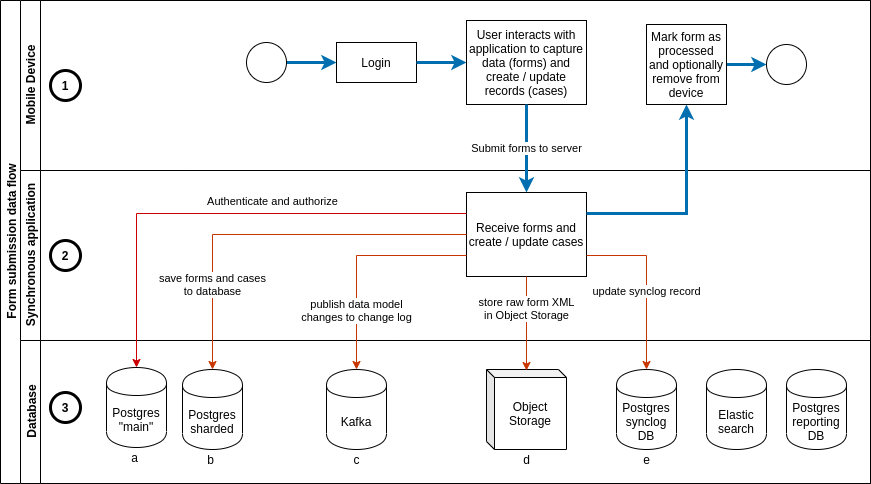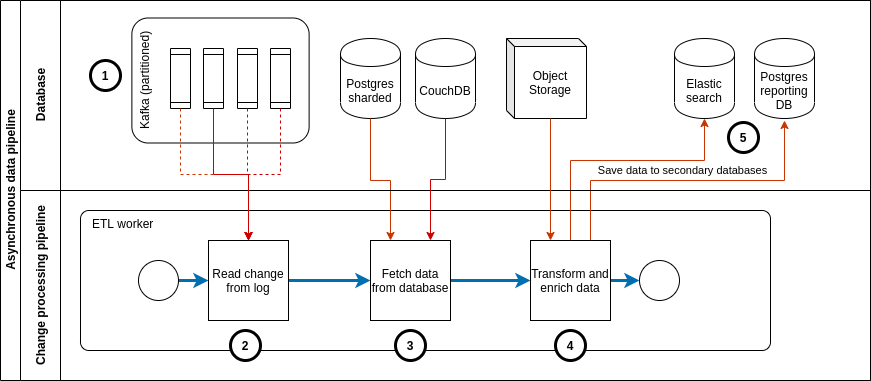CommCare Architecture Overview
CommCare Backend Services
The majority of the code runs inside the server process. This contains all of the data models and services that power the CommCare website.
Each module is a collection of one or more Django applications that each contain the relevant data models, url mappings and view controllers, templates, and Database views necessary to provide that module’s functionality.
Data flow for forms and cases
CommCare deals with many different types of data but the primary data that is generated by users form and case data. This data most often comes from a mobile device running the CommCare mobile application. It may also come from Web Apps, via an integration API or from a case import.
The data processing for form and case data is split into two portions, synchronous processing and asynchronous processing.
Synchronous processing
Form and case data in CommCare always follows the same pathway through the system regardless of whether the data originated from a mobile device (as in the diagram below), from Web Apps, an external integration or from an internal process such as case update rules.
In all instances a form (which may contain zero or more case changes) is received by CommCare and processed synchronously and atomically to the point of persisting it in the primary databases and recording the change in the change log.
The diagram below shows this synchronous processing:

A form is created on a mobile device (this could also be Web Apps, an external system).
The form is received by CommCare and once the request has been authenticated and authorized it is fully processed before responding with a success or error response.
The data is persisted to the various backend data sources.
This SQL database is used for authentication and authorization.
A set of partitioned SQL databases form the primary data store for form and case data.
Once processing is complete a metadata record is published to the change log for each data model that was created or updated.
The raw form XML is persisted to object storage (only metadata about the form is saved to the primary database in (b).
If this submission is from a mobile device the sync record for the device is updated to allow efficient synchronization when the mobile device next makes a sync request.
A successful response is sent to the sender.
Asynchronous data pipeline
Separately from the synchronous workflow described above there is a data processing pipeline which runs asynchronously. This pipeline is responsible for populating the secondary databases which are used for reporting and as the datasource for some of the APIs that CommCare offers.

Kafka stores the metadata about data model changes. Kafka partitions the data based on the data model ID (case ID / form ID) and stores each partition separately. Data is sent to Kafka during the synchronous request processing as described above.
A pool of ETL workers (a.k.a. pillows) subscribe to Kafka and receive the metadata records from the partitions they are subscribed to.
Each ETL worker subscribes to a unique set of partitions.
Since each worker is independent of the others the rate of processing can vary between workers or can get delayed due to errors or other external factors.
The impact of this is that data liveness in the secondary database may vary based on the specific components in the pipeline. I.e. two cases which got updated in the same form may be updated in Elasticsearch at different times due to variations in the processing delay between pillow workers.
The ETL workers fetch the data record from the primary database.
For forms and cases this data comes from PostgreSQL
For users and applications this data comes from CouchDB
If the data model is a form then the form XML is also retrieved from object storage. This data together with the record from the primary database are used to produce the final output which is written to the secondary databases.
In the case of UCRs there may be other data that is fetched during the processing stage e.g. locations, users.
Change Processors (Pillows)
Change processors (known in the codebase as pillows) are events that trigger when changes are introduced to the database. CommCare has a suite of tools that listen for new database changes and do additional processing based on those changes. These include the analytics engines, as well as secondary search indices and custom report utilities. All change processors run in independent threads in a separate process from the server process, and are powered by Apache Kafka.
Task Queue
The task queue is used for asynchronous work and periodic tasks. Processes that require a long time and significant computational resources to run are put into the task queue for asynchronous processing. These include data exports, bulk edit operations, and email services. In addition the task queue is used to provide periodic or scheduled functionality, including SMS reminders, scheduled reports, and data forwarding services. The task queue is powered by Celery, an open-source, distributed task queueing framework.
Data Storage Layer
CommCare HQ leverages the following databases for its persistence layer.
PostgreSQL
A large portion of our data is stored in the PostgreSQL database, including case data, form metadata, and user account information.
Also stored in a relational database, are tables of domain-specific transactional reporting data. For a particular reporting need, our User Configurable Reporting framework (UCR) stores a table where each row contains the relevant indicators as well as any values necessary for filtering.
For larger deployments the PostgreSQL database is sharded. Our primary data is sharded using a library called PL/Proxy as well as application logic written in the Python.
PostgreSQL is a powerful, open source object-relational database system. It has more than 15 years of active development and a proven architecture that has earned it a strong reputation for reliability, data integrity, and correctness.
CouchDB
CommCare uses CouchDB as the primary data store for some of its data models, including the application builder metadata and models around multitenancy like domains and user permissions. CouchDB is an open source database designed to be used in web applications. In legacy systems CouchDB was also used to store forms, cases, and SMS records, though these models have moved to PostgreSQL in recent applications.
CouchDB was primarily chosen because it is completely schema-less. All data is stored as JSON documents and views are written to index into the documents to provide fast map-reduce-style querying.
In addition CommCare leverages the CouchDB changes feed heavily to do asynchronous and post processing of our data. This is outlined more fully in the “change processors” section above.
Elasticsearch
Elasticsearch is a flexible and powerful open source, distributed real-time search and analytics engine for the cloud. CommCare uses Elasticsearch for several distinct purposes:
Much of CommCare’s data is defined by users in the application configuration. In order to provide performant reporting and querying of user data CommCare makes use of Elasticsearch.
CommCare also serves portions of the REST API from a read-only copy of form and case data that is replicated in real time to an Elasticsearch service.
This also allows independent scaling of the transactional data services and the reporting services.
Devops Automation
Fabric / Ansible
Fabric and Ansible are deployment automation tools which support the efficient management of cloud resources for operations like deploying new code, rolling out new server hosts, or running maintenance processes like logically resharding distributed database. CommCare uses these tools as the foundation for our cloud management toolkit, which allows us to have predictable and consistent maintenance across a large datacenter.
Dimagi’s tool suite, commcare-cloud is also available on Github
Other services
Nginx (proxy)
CommCare’s main entry point for all traffic to CommCare HQ goes through Nginx. Nginx performs the following functions:
SSL termination
Reverse proxy and load balancing
Request routing to CommCare and Formplayer
Serving static assets
Request caching
Rate limiting (optional)
Redis
Redis is an open source document store that is used for caching in CommCare HQ. Its primary use is for general caching of data that otherwise would require a query to the database to speed up the performance of the site. Redis also is used as a temporary data storage of large binary files for caching export files, image dumps, and other large downloads.
Apache Kafka
Kafka is a distributed streaming platform used for building real-time data pipelines and streaming apps. It is horizontally scalable, fault-tolerant, fast, and runs in production in thousands of companies. It is used in CommCare to create asynchronous feeds that power our change processors (pillows) as part of the reporting pipeline.
RabbitMQ
RabbitMQ is an open source Advanced Message Queuing Protocol (AMQP) compliant server. As mentioned above CommCare uses the Celery framework to execute background tasks. The Celery task queues are managed by RabbitMQ.
Gunicorn
Gunicorn is an out-of-the-box multithreaded HTTP server for Python, including good integration with Django. It allows CommCare to run a number of worker processes on each worker machine with very little additional setup. CommCare is also using a configuration option that allows each worker process to handle multiple requests at a time using the popular event-based concurrency library Gevent. On each worker machine, Gunicorn abstracts the concurrency and exposes our Django application on a single port. After deciding upon a machine through its load balancer, our proxy is then able to forward traffic to this machine’s port as if forwarding to a naive single-threaded implementation such as Django’s built-in “runserver”.